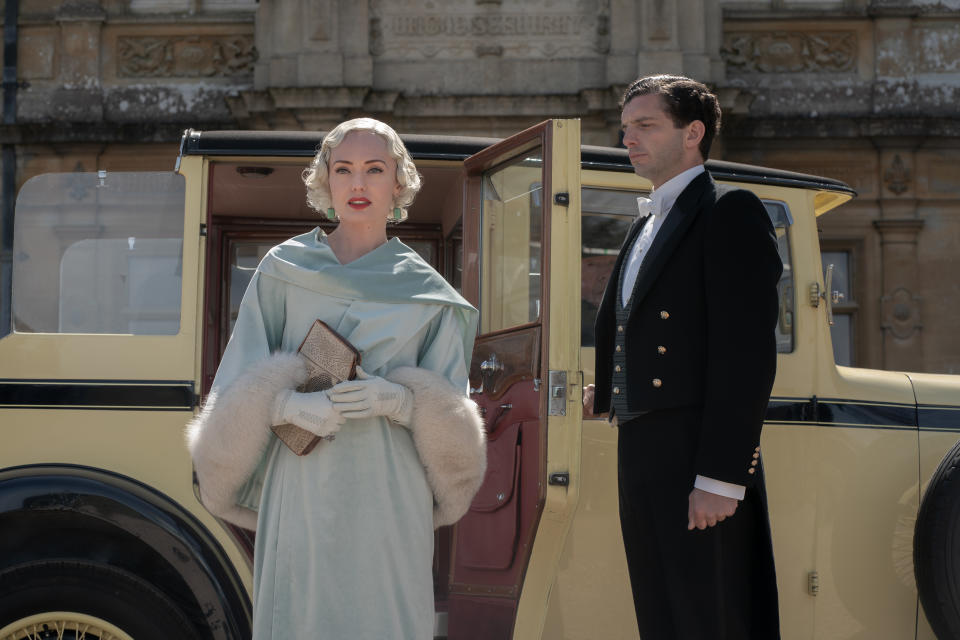‘Downton Abbey: A New Era’: Filmmakers Say, Don’t Call It a ‘Singin’ in the Rain’ Ripoff!

- Oops!Something went wrong.Please try again later.
- Oops!Something went wrong.Please try again later.
For the second feature film in the growing “Downton Abbey” universe, it’s quite literally a new era for the Granthams, thanks to the introduction of motion picture moviemaking on the grand estate itself. In director Simon Curtis’ “Downton Abbey: A New Era,” the family, led by Lady Mary (Michelle Dockery), opens the doors of the family home to a silent film production led by director Jack Barber (Hugh Dancy), in hopes of infusing the estate with some sizable cash. But trouble brews with the arrival of the talkies, leading to a cinema-centric plotline that might sound pretty familiar to fans of classic film.
The film’s screenwriter, series creator Julian Fellowes, told IndieWire that he wanted the film to feature significant shake-ups for the Downton residents and, considering that its events take place in 1928, it only made sense for film to be a focus. “I wanted very much to have something that was absolutely 20th century coming into the house,” Fellowes told IndieWire via Zoom. “For me, this is not original, I think film is the great 20th century art form and has no 19th century equivalent.” Fellowes saw the arrival of film as the perfect “disruption” for the characters to deal with.
More from IndieWire
'Downton Abbey' Sequel Confronts a New Era for Films Aimed at Older Audiences
'Holy Spider' Shows a Side of Iran the Country Doesn't Want You to See
It was that element that attracted Dancy to the project, who was drawn in by the prospect of playing a director, specifically one associated with the silent era. Because the world of Downton is “hermetically sealed,” as Dancy described it, he appreciated that his character Jack was able to come in and “puncture that” to a certain degree. He also drew up a backstory for his character that would explain his motivations.
“He’s very serious about his job. He is creative. If you’re making a movie back then, he’s the director, he’s the producer, he seems to be doing a bit of everything,” Dancy told IndieWire. “The backdrop of all that, for me, was that probably any man of his age at that era would have gone through the First World War. My assumption was he had maybe found his way into the technology of film making due to the war. I feel like when you’ve been through the First World War, you’re less concerned with the prestige.”
A fan of comedian Buster Keaton, the role was an opportunity for Dancy to upend some of the preconceptions he had about the era. “It was something that I associated with, for want of a better word, overacting, and what I learned was [that was] maybe not so fair,” he said. “They were making movies that were far more subtle, and operating on a quieter level, in a good way, than what I had understood silent moviemaking to be. So that was helpful for me to think, ‘It’s not all pantomime. He’s trying to tell a story and find the truth in it.'”

Ben Blackall
In watching the plot unfold, audiences might immediately be struck by the similarities between the film and 1952’s “Singin’ in the Rain,” starring Gene Kelly as a silent movie actor trying to find a new way to tell stories in the era of talking pictures. Like “Downton Abbey: A New Era,” that film also stars an actress with a voice at odds with the characters she plays.
But Fellowes and Curtis said the movie isn’t directly inspired by Kelly’s feature. Instead, both filmmakers cited “Downton” producer Gareth Neame as offering his own canny inspiration. Neame’s grandfather Ronald Neame worked on Alfred Hitchcock’s 1929 silent feature “Blackmail.”
“In that film, they had exactly the situation I lifted for ‘Downton,’ when they suddenly had to change it over halfway through and they had, not a leading lady with an ugly voice, but she was foreign and could hardly speak English,” Fellowes said. “So, because the science of looping was all in the future, they have to get another actress to come and stand on the set and she had to move her mouth while this other woman spoke into the mic. As he [Gareth Neame] was describing it, I thought, ‘That’s for me.'”
The film also had a technical advisor on-set explaining techniques that would have been on a silent era set. According to Curtis, the crew was serious about presenting things authentically, including making sure the housing for the on-set camera would be contained in a box to reduce noise, which mimicked the kind of set-up that would have been present during films of the era.
To aid in the authenticity of the actors playing the in-movie stars, particularly Laura Haddock’s role as spoiled superstar Myrna Dalgleish, Curtis and Haddock took to hastily putting together a brief snippet of a fictional movie starring Myrna that Jack and Lady Mary would later watch in a movie theater. “That was something Laura Haddock and I conjured out of thin air,” said Curtis. “It looks incredibly authentic, by the miracle of filmmaking.”
Focus Features will release “Downton Abbey: A New Era” in theaters on Friday, May 20.
Best of IndieWire
Every Palme d'Or Winner From the Cannes Film Festival, Ranked
New Movies: Release Calendar for May 13, Plus Where to Watch the Latest Films
The Best Sex Scenes of the 21st Century Ranked, from 'Midsommar' to 'Titane'
Sign up for Indiewire's Newsletter. For the latest news, follow us on Facebook, Twitter, and Instagram.

